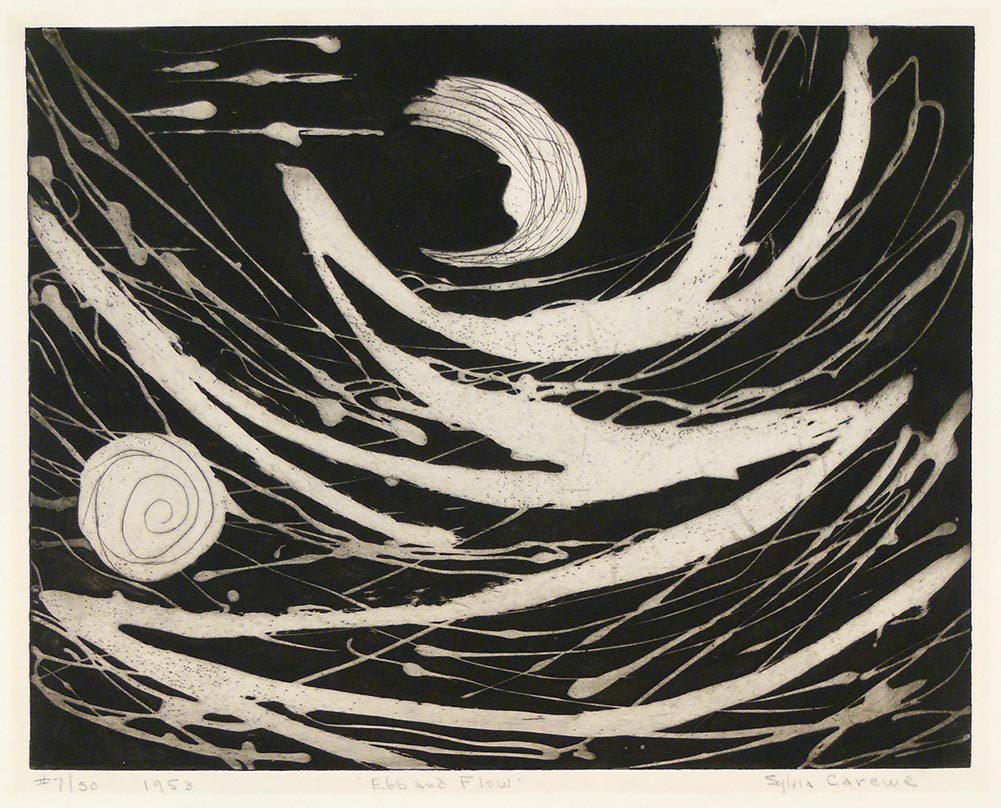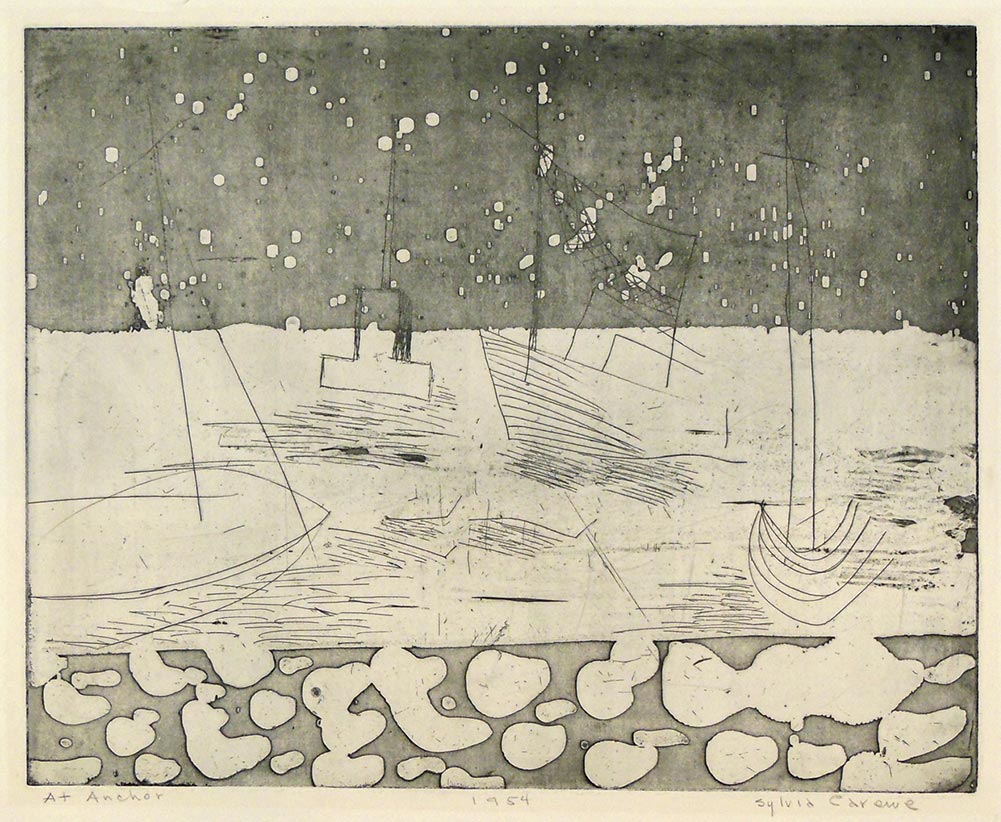15. Sylvia Carewe
| Life Dates | 1906-1981 |
| Place of Birth | New York, NY, USA |
| Place of Death | New York, NY, USA |
| Birth Name | Sylvia Kerewsky |
Sylvia Carewe (née Kerewsky) was the oldest daughter and second child born to Esther and Louis Kerewsky, who immigrated to New York City from Uman, Russia (now central Ukraine) in 1899.1 She changed her last name to Carewe around 1930 and entered the advertising industry after attending Columbia University.2 Carewe acted in a multifaceted role in advertising, writing ad copy, drawing images, executing market research.3 She began to work as a fine artist around 1943. After her marriage in October 1944, Carewe switched from commercial to fine art and, by September 1947, she had her first solo exhibition of paintings and gouaches at The Three Arts, a gallery in Poughkeepsie, New York, near where she and her husband, Marvin Small—also advertising executive and businessman—had a summer home in Millbrook, New York.4 The couple became increasingly involved within the New York and Paris arts community as collectors of modern art and as friends of artists, dealers and others in the art world. Carewe had three solo exhibitions at ACA Gallery (1948, 1950, 1953), the first as a result of winning an annual competition. During these early years, her paintings were very boldly colored, figurative abstractions executed in a primitive style, which mostly captured the locales from her frequent travels. Carewe was largely self-taught and had brief instruction with Hans Hofmann and Yasuo Kuniyoshi. Between January 1953 and May 1954, she worked at Atelier 17 and made several etchings, which she showed at The Three Arts in March 1954.5 Dorothy Dehner and I. Rice Pereira were close friends of Carewe’s at this time, and it is possible that one of them may have introduced her to Atelier 17. Two rare impressions of Carewe’s early etchings, likely created at Atelier 17, evidence her experimentation with printmaking techniques.6 In the first, Ebb and Flow (1953), Carewe dribbled stop-out varnish abstractly onto the plate and completed it by etching a spiral design into the white circle and lines into the crescent shape. This work was a forerunner to a tapestry design, La Firmament, that Carewe would create in the late 1950s and early 1960s with Braquenié & Cie, the renown weaver in Aubusson, France. The second, At Anchor (1954), features a very primitive, nocturnal composition of several boats and buoys rocking on the waves—a frequent motif of Carewe’s work through several media.
Carewe continued to create prints through the late 1950s, expanding the complexity of her designs and also trying her hand at lithography, though she turned her focus increasingly to nocturnal paintings and drawings of city lights, and, more importantly, tapestry design. Encouraged by Katia Granoff, who represented the artist’s work in Paris, Carewe was one of the earliest modern artists—and one of the first women—to adopt the historic art form, a precursor to the explosion of modern tapestry manufacture during the 1960s and 1970s.7 She worked under the sponsorship of the French cultural attaché and created original cartons for her tapestry designs, which were produced with Braquenié & Cie. Represented by French & Company in New York, Carewe’s tapestries were well received, and John and Jacqueline Kennedy purchased one for their apartment at the Carlyle Hotel.8 In addition to the visual arts, Carewe was a prolific poet and writer of short stories.9
Archives
Sylvia Carewe Papers, Special Collections Research Center, Syracuse University Libraries
Sylvia Carewe Papers, ca. 1930-1972, Archives of American Art, Smithsonian Institution
Selected bibliography
“Art Show Planned by Sylvia Carewe.” Poughkeepsie Journal, October 4, 1950.
B. G. “Sylvia Carewe.” Art News 51 (January 1953): 50.
“Les Girls.” Time, November 11, 1957.
Louchheim, Aline B. “Huckster-Poet Paints.” Art Digest 23 (November 1, 1948): 20.
“New York Artist’s Work To Go on Display Here Today.” Palladium-Item. April 3, 1955.
P. B. “Sylvia Carewe.” Art Digest 27 (January 15, 1953): 17.
“Personal Mention.” Poughkeepsie Journal, February 27, 1954.
“Rundel Gallery.” Democrat and Chronicle. July 25, 1954.
“Sylvia Carewe.” Art News 47 (October 1948): 59.
“Sylvia Carewe.” Art News 49 (October 1950): 51.
“Sylvia Carewe, Artist, to Give Exhibition.” Poughkeepsie Journal, October 3, 1948.
Notes
- Information about Carewe’s family comes from Louis Kerewsky’s Declaration of Intention to become a naturalized citizen of the United States, dated April 6, 1910: National Archives and Records Administration, Washington, DC, Records of District Courts of the United States, 1685-2009: RG 21. Additional data about the Kerewsky family is available in the 1910 census (Brooklyn Ward 26, Kings, New York; Roll: T624_978; Page: 9A; Enumeration District: 0807; FHL microfilm: 1374991) and 1920 census (Manhattan Assembly District 6, New York, New York; Roll: T625_1196; Page: 9B; Enumeration District: 501). ↩
- The finding aid for Carewe’s papers at Syracuse University Libraries contains a basic outline of the artist’s life. Unless otherwise noted, biographical and professional details are courtesy of John Small, telephone conversation with Christina Weyl, February 14, 2017, several emails with Small over the winter of 2017 and summer 2019, and a biography Carewe sketched in the 1960s courtesy of John Small. ↩
- Melissa A. McEuen mentions Carewe’s work in advertising in Making War, Making Women: Femininity and Duty on the American Home Front, 1941-1945 (Athens, GA: University of Georgia Press, 2011), 179. Carewe was also involved in selecting talent and writing scripts for soap operas on the radio, as part of managing several Proctor and Gamble accounts. Emails and conversations with John Small. ↩
- “Sylvia Carewe,” Poughkeepsie, NY: The Three Arts, September 2-30, 1947, courtesy John Small (Carewe’s son). A handwritten biography found in the Grippe Collection at the Allentown Art Museum lays out a helpful summary of Carewe’s early exhibition history. ↩
- Student ledger book, p. 4, Allentown Art Museum/Grippe Collection, Allentown, Penn. Notice of Carewe’s show can be found in “Personal Mention,” Poughkeepsie Journal, February 27, 1954, 3. An exhibition catalogue for this show has not yet been found. ↩
- The artist’s estate donated these prints to the Grey Art Gallery at New York University. ↩
- For a survey of the postwar explosion of modern tapestry, see K. L. H. Wells, Weaving Modernism: Postwar Tapestry between Paris and New York (New Haven: Yale University Press, 2019). ↩
- Two of her tapestries and one full size carton are in the permanent collection of the Metropolitan Museum of Art: The City, 1959 (1974.292) and The Fire, 1960 (1981.502.1) and its carton (1981.502.2). ↩
- Carewe’s archives at the Archives of American Art and Syracuse University contain many examples of her writing. ↩


